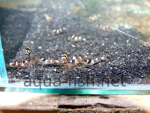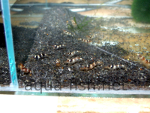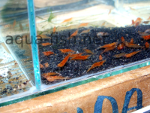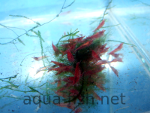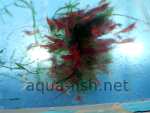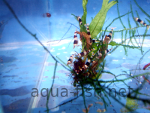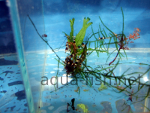Caridina Japonica – Amano shrimp - Proper care, feeding, breeding & forum
Quick links - Answers
Brief Description
This page is devoted to raising Amano shrimp in fish tanks. Our forum which can be found under the article also contains useful information and experiences and we'd like you to submit your experiences with Caridina japonica too! If you came here searching for purchasing Amano shrimp online, simply follow this link!
Introduction
Caridina japonica is the most common shrimp present in aquariums, is also known as Amano Shrimp because Takashi Amano has been the first one to introduce them in his aquariums, noticing their habit to eat algae. This aquarium creature, native of Japan, Korea and Taiwan, is a small transparent grey shrimp with black spots covering the body and a white line from the head to the tail; the body colour can anyway change a bit due food nutrients and water quality.
Aquarium life
Amano shrimp can live in every aquarium, prefer neutral or lightly acid pH, temperature can fluctuate between 71°F and 82°F (22°C – 28°C), while water hardness has not to be too much soft, because being a crustacean Caridina needs calcium and other minerals to grow healthy.
Being really shy, it is better to house them in large groups in the aquarium, or they would spend the most of the time hidden among plants and decorations. There is not a maximum number of Caridina you can house in your tank, overpopulation is really difficult; they live on the ground of your aquarium, so you do not have to calculate the water mass, but the free surface where they can move; reduce their number in case you have fish swimming in the lower part of the tank, because they could be not pleased by caridina massive presence in their territory.
Even though those little shrimps are really able to hide from predators, consider not to buy them if you have big aggressive fish that could eat them easily, specially during the moult. Caridina japonica, like other shrimps, moults to renew its shell; young shrimps moult more often, even once a week, because of their body growing fast, reaching the adulthood they moult less often, approximately few times a year. Maybe you have been able to find a transparent white shell of Caridina floating in the water, that is the old moult, it does not mean your shrimp is dead. During this period, until the new shell gets hard, Caridina hide more than usual because they are really delicate and can be eaten or injured by the other animals in the tank.
Remember, in case of water treatment with medicaments and disinfectant to take the shrimps out of the tank; even if they seem to endure some water treatment, they suffer a lot oxygen decrease.
The Shrimp Farm
TheShrimpFarm.com offers freshwater aquarium shrimp!
Feeding the Amano shrimp
Caridina Japonica are known to eat algae, anyway remember they are not a solution against algae proliferation because they are too small and do not eat that much, moreover they like just some kind of algae and ignore others. The only one solution to algae problems is to control the aquarium balance: lighting period and quality, filtration work, fish and plants number.
Living on the ground, these shrimp also eat the rests of the fish food, and sometimes also other organic refuses. Even if they eat algae they rarely eat plants, both living or dead; while they often like dead fish, a medium group of Caridina can clean the fish carcass really fast.
Even though they can find food almost everywhere in the tank, once a week or so, feed them with specific food or with fish pellets, some of them seem to appreciate a lot Spirulina pellets.
Breeding
Breeding Caridina japonica is quite easy. Sexual dimorphism is really evident: adult males reach 3 cm (1.18 inch) while females are bigger and reach 5 - 6 cm (1.97 - 2.36 inch). Females have a six – eight weeks long cycle, when they are ready to breed they produce sex pheromones, that make change the behaviour of males in the tank: you can understand that a female is ready because males start swimming almost without control around all the tank trying to find the female. Females keep eggs for five weeks and then hatches hundreds of larvae.
Larvae growing is much bigger problem in breeding Caridina because they are really small, almost invisible and eat only phytoplankton. Phytoplankton is made of small vegetable organisms present in the water, it is almost impossible to find them bottled in shops, anyway it can be naturally present in mature aquariums. The other problem with larvae is that being such small they surely end in the filter or in the mouth of fish, so the only solution is to breed in a separated tank.
You can set up a 20 litres (5.28 US gallons, 4.40 Imperial gallons) small tank without gravel on the ground and with some hiding places, both natural or artificial; it is important not to put a filter, you can use a small oxygenator at its place. Prior to breeding, it is important to get the future larvae food; You have various options, anyway a good working solution is to put a small tank of water under direct sunlight outside your house, when water gets green for algae you can start breeding because this mean that water is full of phytoplankton.
Put a carrying eggs female with two or more males for some days, you should be able to see them mating, because males tend to cover the female the most of the time. When the female hatches the larvae you can take her back in the aquarium with other Caridina.
From this point take some green water of the “food tank” with a syringe without needle and add it in the breeding tank. Do this daily even more times at day.
When they reach two or three weeks of age, they start to be visible and you can try to add some small quantities of Spirulina powder or powered fish food. At around six week of age they do the first moult and begin to look like adult Caridina, at this point you can feed them with the same adult food as well and can decide to put them in the community tank in case there are a good number of hiding places.
As mentioned above, breeding is quite easy, problem with larvae will be surely solved with the personal experience. Bear in mind that Caridina are able to breed about every two months and if kept, you probably have some females in your tank, so it gives them the chance to breed often.
Copyright note: This article is originally written by Michela Ferretti. Aqua-fish.net owns the full copyright of this article.
Places where to buy Amano shrimp online
If one or more links from the list shown below doesn't work, tell us, please! Use a form at the bottom of this page and we'll update it!
